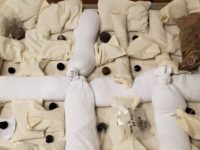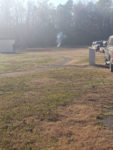 A group of hand grenades from the Revolutionary War have been detonated 238 years after the last shot was fired. The 25 balls filled with gunpowder had slumbered quietly in the stores of Virginia’s Department of Historic Resources (DHR) for 30 years, or so it seemed.
A group of hand grenades from the Revolutionary War have been detonated 238 years after the last shot was fired. The 25 balls filled with gunpowder had slumbered quietly in the stores of Virginia’s Department of Historic Resources (DHR) for 30 years, or so it seemed.
The grenades came from the wreck of The Betsy, a British collier built in Whitehaven in 1772 that transported coal during the Revolutionary War. In September of 1781, General Charles Cornwallis ordered it scuttled along with dozens of other British ships along the shore of the York River during the Siege of Yorktown in the attempt to prevent the French fleet controlling Chesapeake Bay from attacking British forces on land. The attempt failed and Corwallis, hemmed in on land by the Continental Army and reinforcements by sea blocked by the French navy, surrendered on October 19th, 1781. It was the last major battle of the American Revolution.
The French were granted title to all the British ships after the surrender, including the wrecks. They spent the winter of 1781-2 salvaging what they could. Two centuries later, a team of DHR archaeologists investigated the wrecks to see if there were any artifacts left to recover. A cofferdam was built around the Betsy, the water filtered out and a suprising number of objects spotted. Half of the ship’s contents remained in situ. About 5,000 objects were recovered, inventoried and stored in the DHR collection.
Budget cuts interrupted the arduous process of fully documenting the finds and conservation of maritime archaeological materials wasn’t as sophisticated in 1982 as it is now. The grenades, corroded and caked with concretions, weren’t recognized as grenades. They were about the size of balls for small cannon, so they were temporarily classified as “shot,” bagged, placed in cardboard boxes and shelved until they could be X-rayed. The budget axe dropped before the X-rays could show that they weren’t solid lead balls.
Last fall, DHR’s conservation lab got a grant from the National Park Service to study and conserve the Betsy‘s many artifacts. Their focus was on the organic materials — leather, rope, wood — which quickly deteriorate once removed from a waterlogged environment and preservation techniques are vastly improved now. The box with the “shot” wasn’t high priority because metal doesn’t decay, so it was set aside for later examination.
On Nov. 28, [DHR conservator Kate] Ridgway was working her way through that box in the lab when she pulled out a plastic bag labeled “shot.” Inside: a gray-ish round clump not much bigger than a golf ball.
“I knew right away something wasn’t right,” Ridgway said. “It wasn’t heavy enough to be lead shot. And it had these weird cracks in it. And what looked like crystals inside.”
When she opened the bag, she caught the scent of something ominous.
A whiff of gunpowder crossed 237 years and drifted up. […]
Ridgway figured it could be [live], especially after three decades of drying time. She carried that first strange ball to a microscope. Those were definitely crystals inside.
“I am not happy,” she told [head conservator Chelsea] Blake, before turning to her computer to search for information about weapons of The Betsy’s era. It dawned on her that this ball could be the core of a grenade, what was left after the iron shell had long dissolved.
Ridgway crossed the lab to another instrument that identifies chemical elements. Sulfur. And potassium. The ingredients of gunpowder.
“I am really not happy,” Ridgway said. “We’re done here. Call the police.”
 The Richmond bomb squad removed the grenade to a bomb truck and detonated it. A white plume of smoke wafted up, the tell-tale sign of burning black powder. After two centuries underwater and 240 years since it was deployed, that grenade was still dangerous.
The Richmond bomb squad removed the grenade to a bomb truck and detonated it. A white plume of smoke wafted up, the tell-tale sign of burning black powder. After two centuries underwater and 240 years since it was deployed, that grenade was still dangerous.
The bomb squad was called twice more within days as more of the grenades were found. Conservators realized they had to go through all the Betsy stores to deal with their explosive artifacts all at once. It was a huge production.
Most of December was spent crafting plans and preparing the lab. Guided by the bomb squad and following munitions factory rules, they removed anything that could produce a static spark — plastic, scraping chairs, squeaky carts. Tables were covered with cotton fabric. Extra humidifiers were brought in. Flammable chemicals were carried away.
On Saturday, Dec. 29, they came in just after dawn — Ridgway, Blake, collections assistant Andrew Foster and archaeologist Mike Clem.
All other employees had been told to stay away. Neighbors across the street had been notified with a letter. Experts from an alphabet soup of agencies — FBI, ATF, bomb techs from the city, county and state police — met the four at the lab, parking in a side lot to avoid causing a scene. The fire department and medics stood by.
“We didn’t want to endanger anyone else, but we didn’t want to panic them either,” Ridgway said. “We did whatever law enforcement advised us to do.”
The bomb squads provided helmets, vests and thick aprons for the staffers, who had come to work dressed only in cotton clothing and rubber-soled shoes. Each staffer was assigned a personal bomb tech handler.
“We had 18 people in here,” Ridgway said. “We couldn’t have asked for better help.”
Eight hours later, they’d combed through every single box. And found 20 more grenades. One was still wearing its iron jacket.
They were all detonated safely.